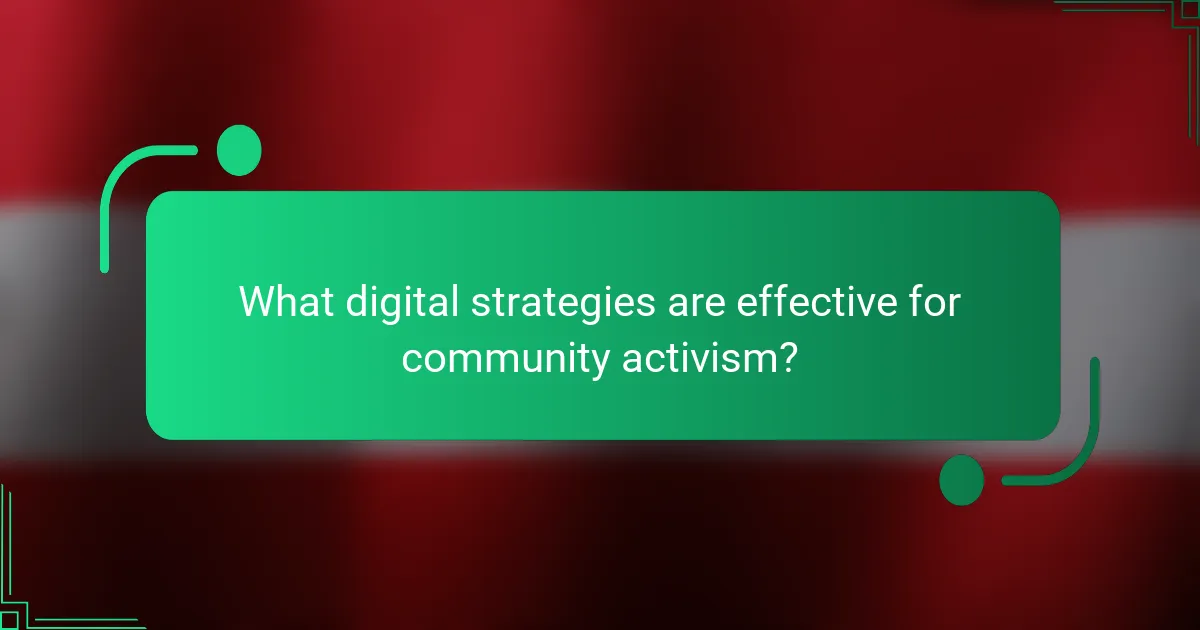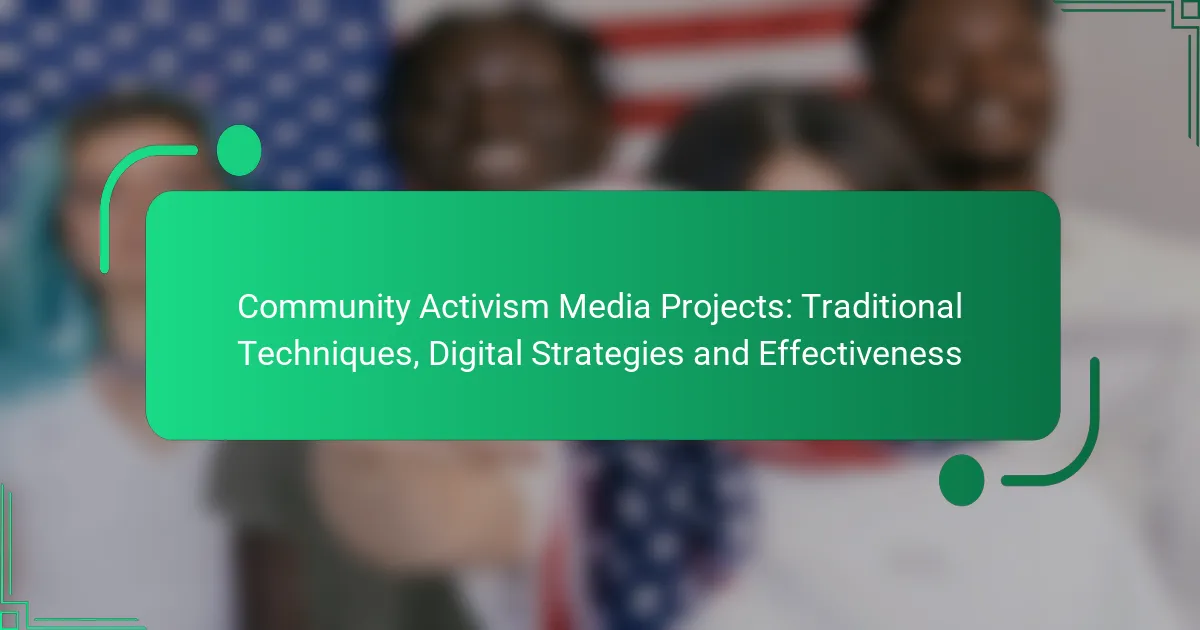Community activism media projects thrive on a blend of traditional techniques and digital strategies, each offering unique advantages. Traditional methods foster direct engagement and trust within local communities, while digital strategies expand outreach and mobilization through online platforms. By effectively integrating these approaches, activists can enhance their impact and drive meaningful change.

How can traditional techniques enhance community activism media projects?
Traditional techniques can significantly enhance community activism media projects by fostering direct engagement and building trust within the community. These methods often leverage personal connections and local knowledge, making them effective for mobilizing support and raising awareness.
Grassroots organizing
Grassroots organizing involves mobilizing community members to advocate for change at the local level. This technique relies on building relationships and encouraging participation through meetings, door-to-door outreach, and local events. Effective grassroots efforts can create a strong base of support that amplifies the voices of community members.
To be successful, organizers should focus on identifying key community leaders and influencers who can help rally support. Regular communication and feedback loops are essential to keep the community engaged and informed about ongoing initiatives.
Community workshops
Community workshops serve as interactive platforms for education and skill-building, empowering participants to take action on issues that matter to them. These workshops can cover topics such as advocacy strategies, media literacy, and public speaking, equipping attendees with the tools needed for effective activism.
When planning workshops, consider the specific needs and interests of the community. Offering sessions in accessible locations and at convenient times can increase participation. Providing materials in multiple languages may also enhance inclusivity.
Public demonstrations
Public demonstrations are powerful visual expressions of community solidarity and can draw significant media attention. These events can range from small gatherings to large marches, depending on the issue and the level of community support. A well-organized demonstration can effectively communicate a message and mobilize further action.
To maximize impact, ensure that demonstrations are well-planned with clear objectives, permits if necessary, and safety measures in place. Engaging local media before and after the event can help amplify the message and reach a broader audience.
Local partnerships
Forming local partnerships with organizations, businesses, and institutions can enhance the reach and effectiveness of community activism projects. Collaborating with established entities can provide additional resources, expertise, and credibility to initiatives.
Identify potential partners who share similar values and goals. Building these relationships can lead to joint events, shared resources, and increased visibility for community issues. Regular communication and mutual support are key to maintaining these partnerships.
Print media campaigns
Print media campaigns, including flyers, posters, and newsletters, remain effective tools for reaching local audiences. These materials can convey important information about community issues, upcoming events, and ways to get involved. Well-designed print media can capture attention and encourage action.
When creating print materials, focus on clear messaging and eye-catching designs. Distributing these materials in high-traffic areas, community centers, and local businesses can maximize visibility. Consider using local language and culturally relevant imagery to resonate with the target audience.

What digital strategies are effective for community activism?
Effective digital strategies for community activism include leveraging social media, online petitions, virtual town halls, and influencer collaborations. These methods enhance outreach, engagement, and mobilization, allowing activists to connect with broader audiences and drive meaningful change.
Social media engagement
Social media engagement is crucial for community activism as it allows activists to share messages, rally support, and foster discussions. Platforms like Facebook, Twitter, and Instagram enable real-time communication and can amplify a cause’s visibility.
To maximize impact, create shareable content, use relevant hashtags, and engage with followers through comments and direct messages. Regular updates and interactive posts can keep the community involved and informed.
Online petitions
Online petitions are a powerful tool for gathering support and demonstrating public interest in a cause. Platforms like Change.org and Care2 make it easy to create and share petitions, allowing activists to collect signatures from around the world.
When crafting a petition, be clear about the goal and the action you want to achieve. Promote it through social media and email campaigns to reach a wider audience. Aim for a specific target number of signatures to create a sense of urgency and legitimacy.
Virtual town halls
Virtual town halls provide a platform for community members to discuss issues and share ideas in real-time. Using tools like Zoom or Microsoft Teams, activists can host discussions that include Q&A sessions, allowing for direct interaction with participants.
To ensure success, promote the event well in advance and encourage participation through social media and community networks. Prepare an agenda to keep the discussion focused and productive, and consider recording the session for those who cannot attend live.
Influencer collaborations
Collaborating with influencers can significantly boost the reach of community activism efforts. Influencers with a strong following can lend credibility and attract attention to specific causes, making them valuable allies.
When seeking collaborations, choose influencers whose values align with your cause. Clearly outline the goals of the partnership and provide them with the necessary information to communicate effectively. This can lead to authentic endorsements that resonate with their audience.

How do traditional and digital strategies compare in effectiveness?
Traditional and digital strategies each have unique strengths and weaknesses in community activism media projects. While traditional methods often rely on face-to-face interactions and physical materials, digital strategies leverage online platforms to reach a broader audience quickly.
Audience reach
Traditional strategies, such as flyers or community meetings, typically engage local audiences effectively but may struggle to reach wider demographics. In contrast, digital strategies can tap into global networks, allowing campaigns to reach thousands or even millions of people through social media, websites, and email newsletters.
For example, a local event promoted through social media can attract participants from various regions, while a printed flyer may only reach those in the immediate vicinity. This difference highlights the importance of selecting the right strategy based on the target audience’s location and preferences.
Engagement levels
Engagement levels can vary significantly between traditional and digital strategies. Traditional methods often foster deeper personal connections through face-to-face interactions, which can lead to stronger community ties. However, digital platforms provide interactive features such as comments, shares, and likes, which can enhance engagement by allowing immediate feedback and participation.
For instance, a community forum held in person may generate meaningful discussions, while an online campaign can facilitate ongoing conversations across various platforms, keeping the momentum alive even after the initial event.
Cost-effectiveness
Cost-effectiveness is a crucial consideration when comparing traditional and digital strategies. Traditional methods often involve higher upfront costs for printing materials and venue rentals, which can strain budgets, especially for grassroots organizations. Digital strategies, on the other hand, usually require lower financial investment, with many platforms offering free or low-cost options for outreach.
For example, creating a social media campaign can be done with minimal expenses, while a printed brochure may cost significantly more per unit. Organizations should assess their budget and choose the strategy that maximizes their impact without overspending.

What are the prerequisites for launching a media project?
Launching a media project requires a clear understanding of community needs, effective resource allocation, and active stakeholder involvement. These prerequisites ensure that the project is relevant, sustainable, and supported by those it aims to serve.
Community needs assessment
A community needs assessment identifies the specific issues and interests of the target audience. This process typically involves surveys, focus groups, and interviews to gather insights directly from community members.
Consider using tools like SWOT analysis to evaluate strengths, weaknesses, opportunities, and threats related to the community’s media landscape. This can help prioritize the most pressing needs and tailor your project accordingly.
Resource allocation
Effective resource allocation involves identifying and distributing the necessary financial, human, and technological resources for the media project. Start by estimating your budget, which may range from a few hundred to several thousand dollars, depending on the project’s scope.
Ensure that you allocate resources not only for content creation but also for promotion and distribution. A common pitfall is underestimating the costs associated with marketing, which can significantly impact the project’s reach and effectiveness.
Stakeholder involvement
Engaging stakeholders is crucial for the success of a media project. This includes community members, local organizations, and potential sponsors who can provide support and resources. Building relationships with these groups fosters collaboration and enhances project credibility.
Consider forming a steering committee that includes diverse stakeholders to guide the project. Regular meetings and updates will help maintain engagement and adapt the project based on feedback and changing community dynamics.
